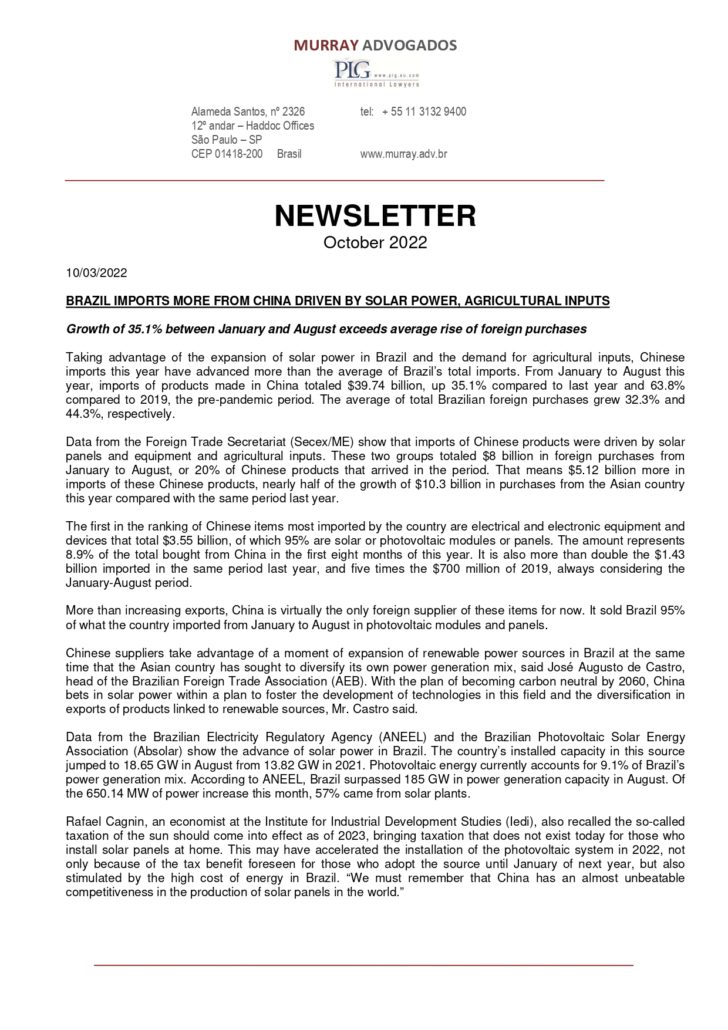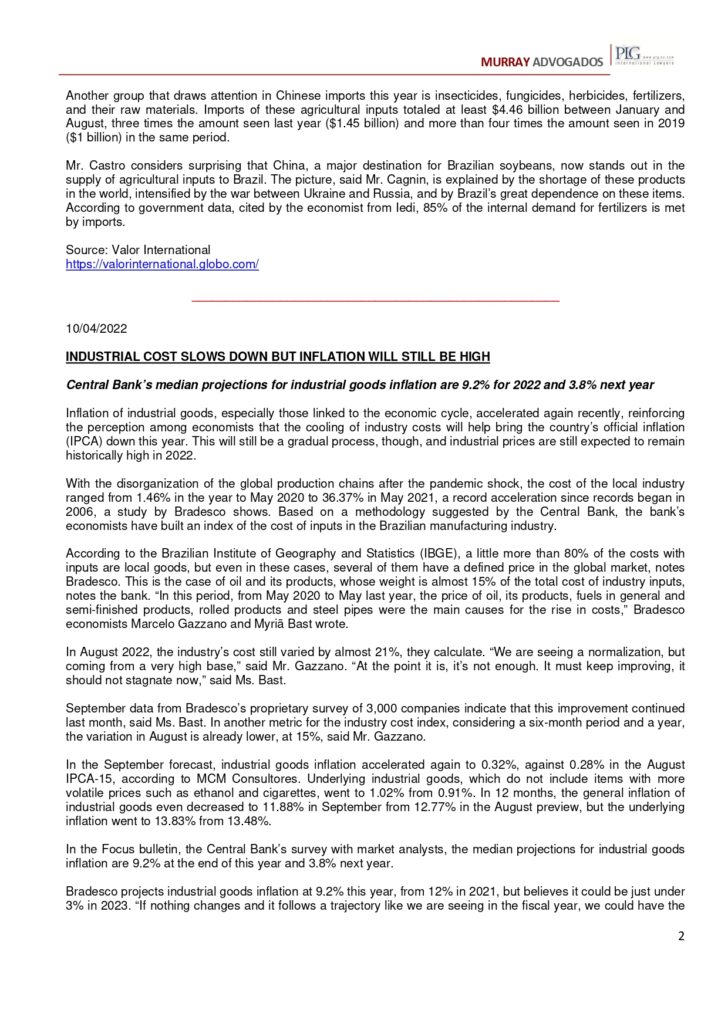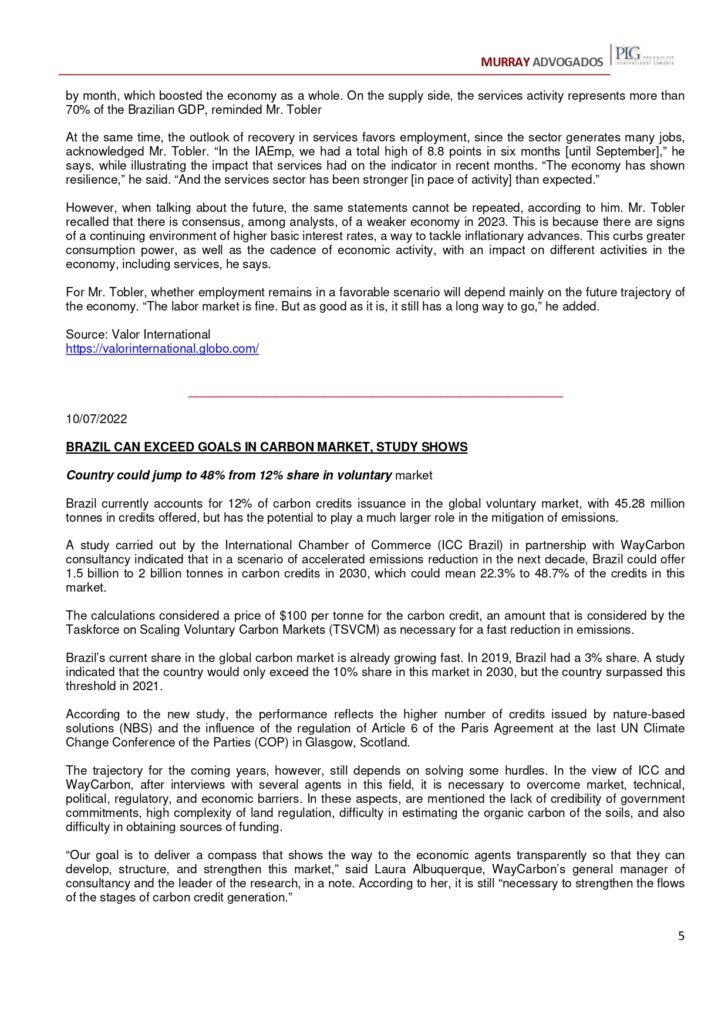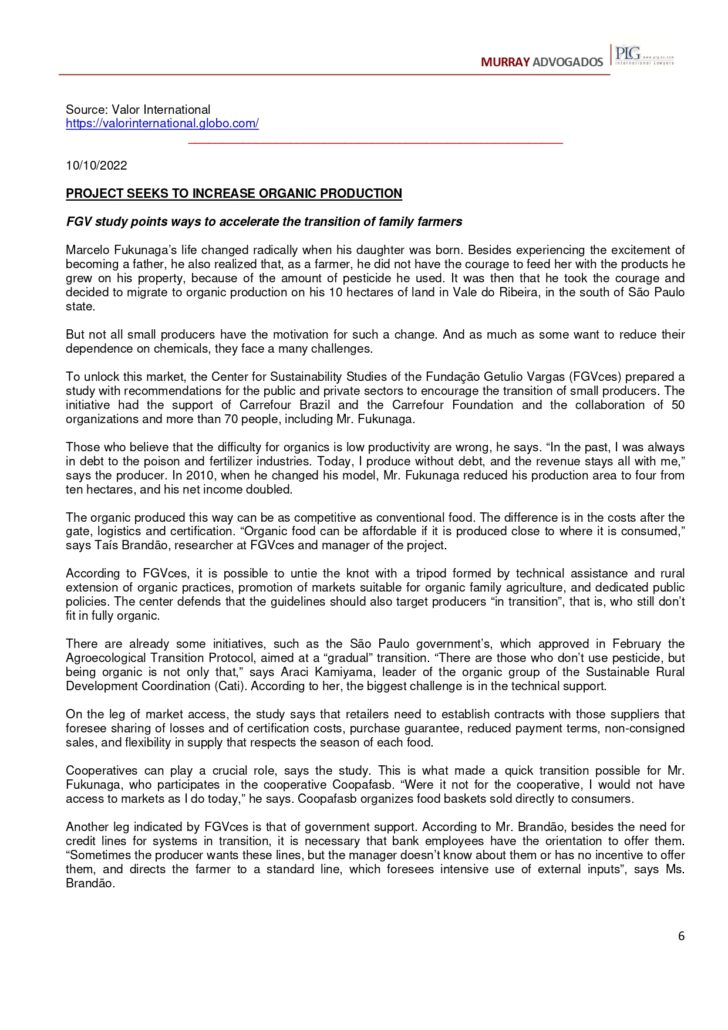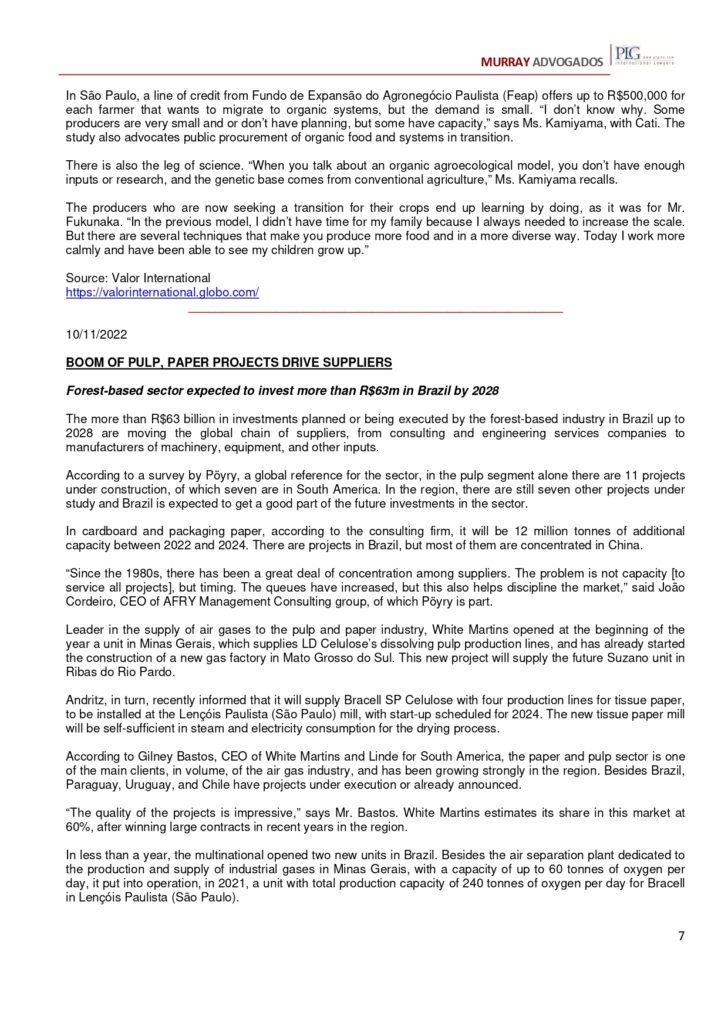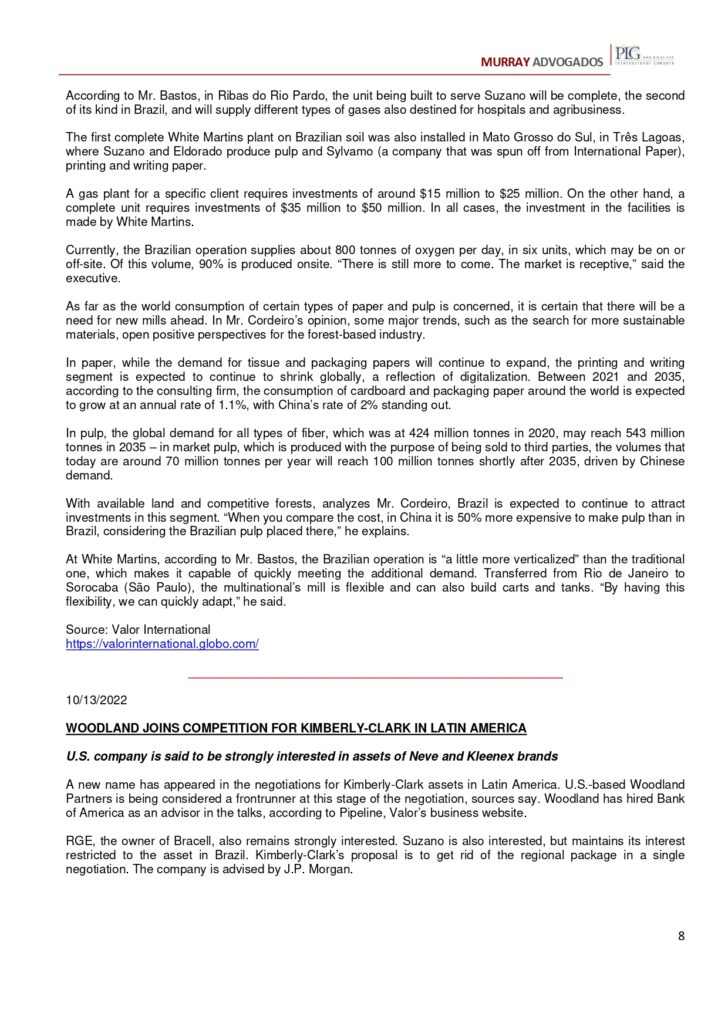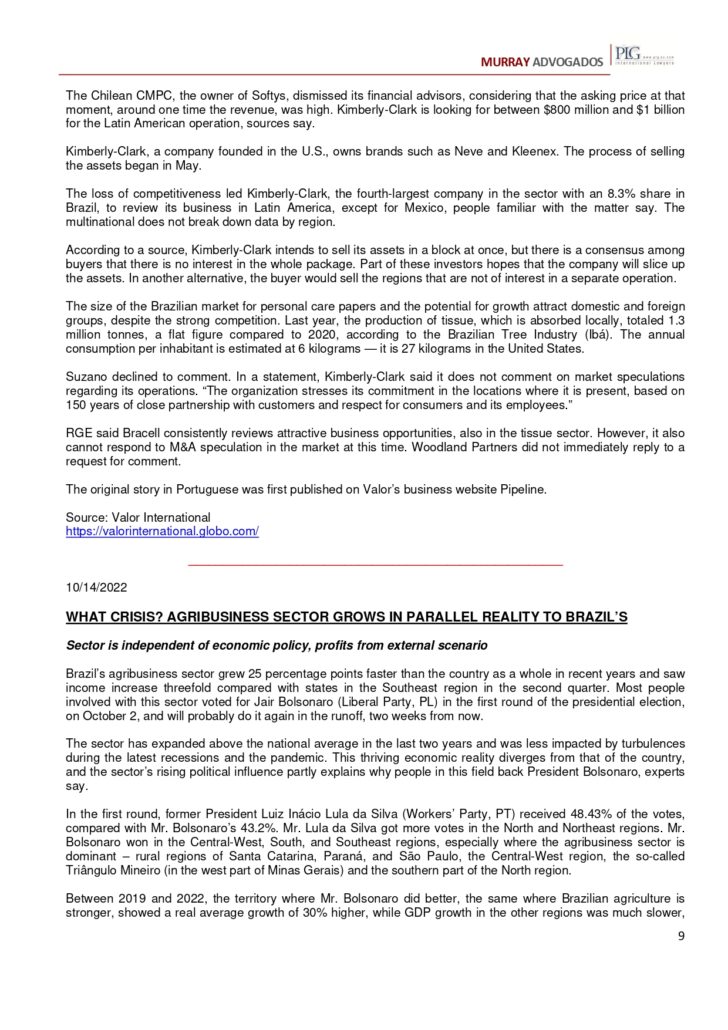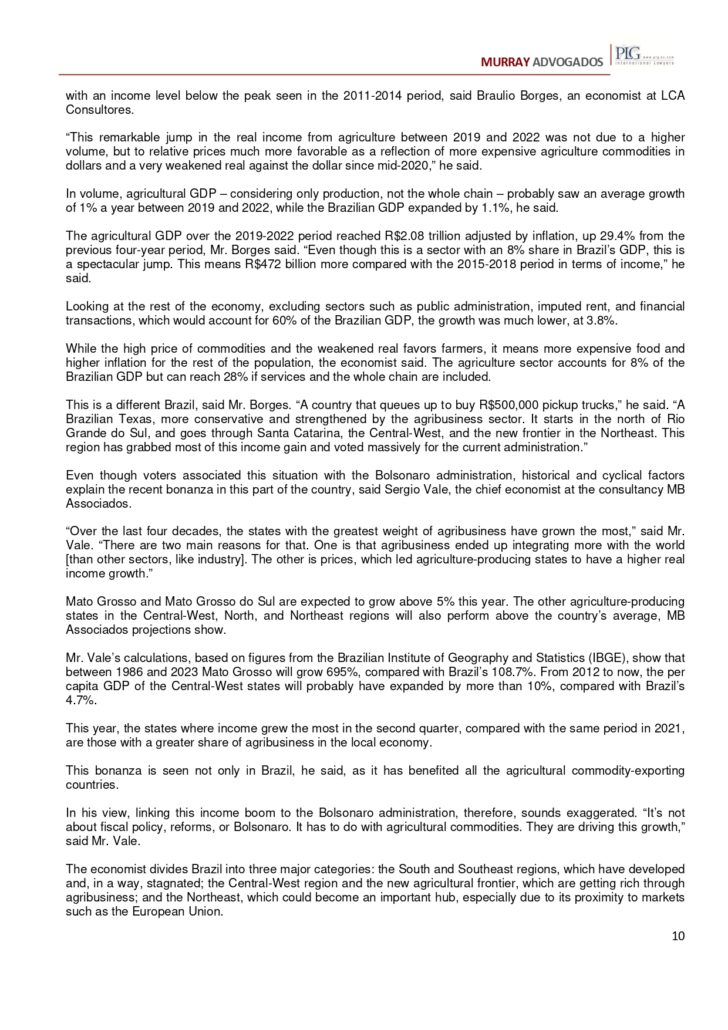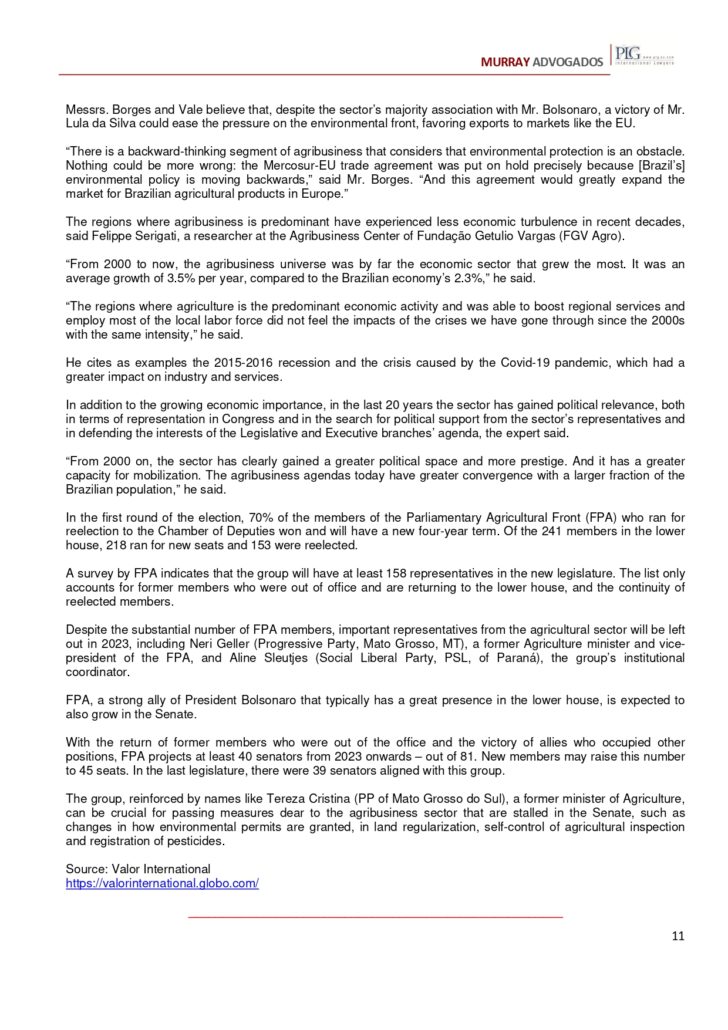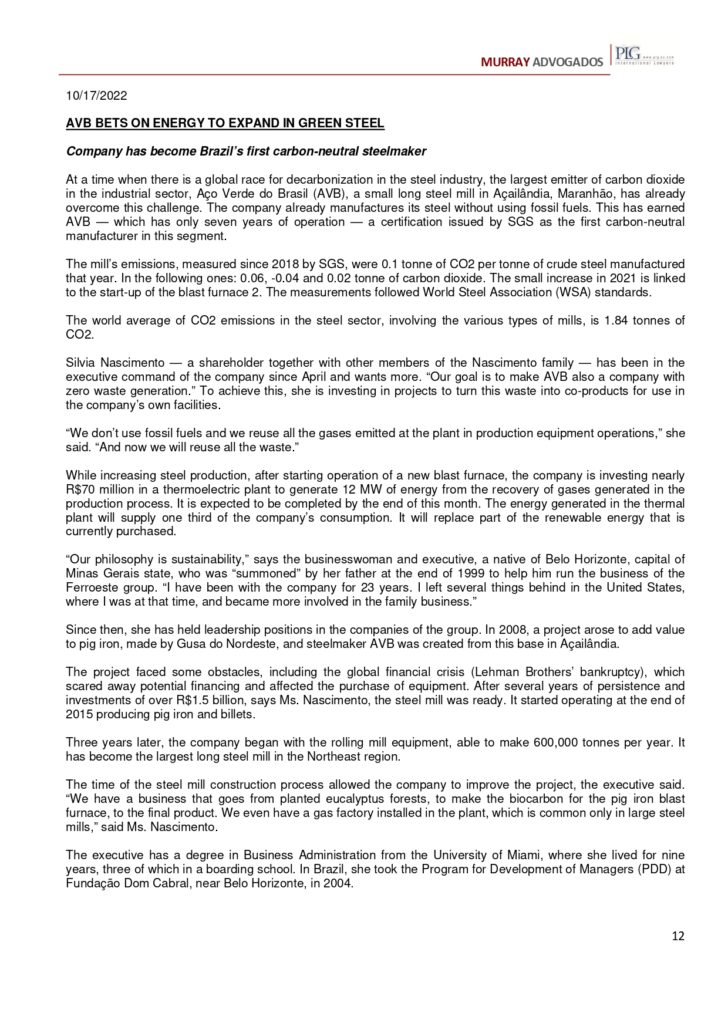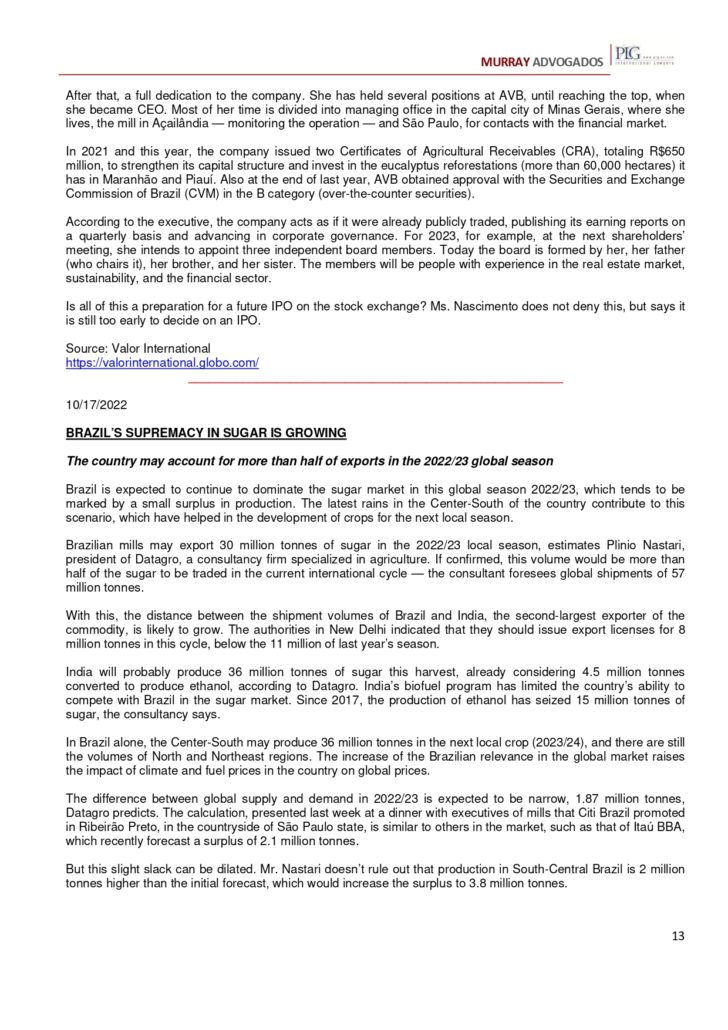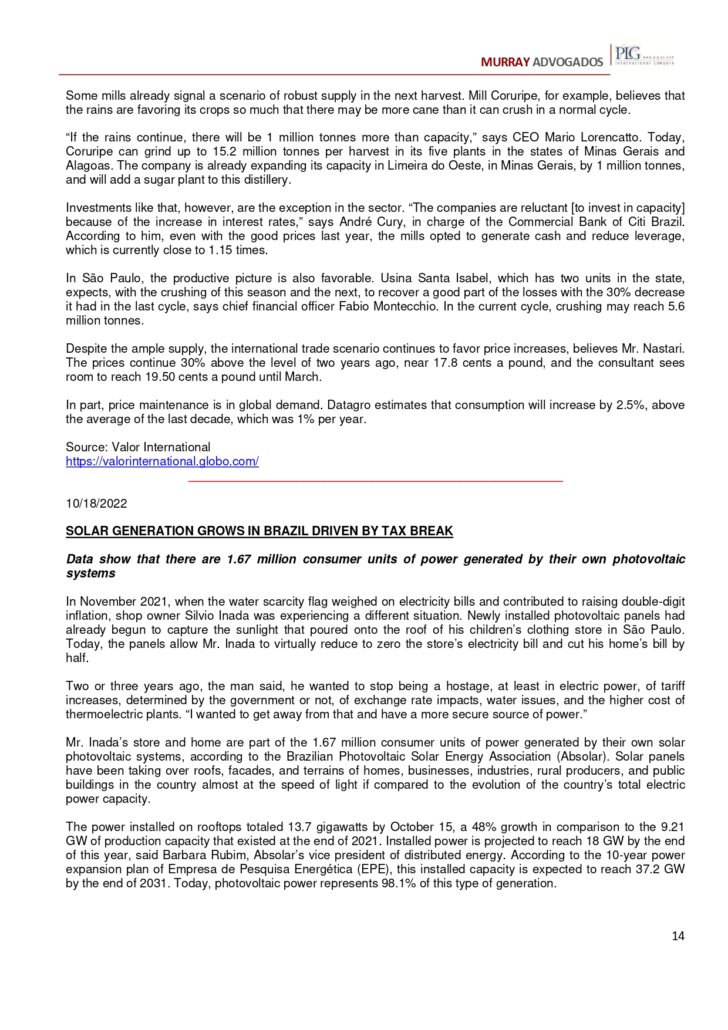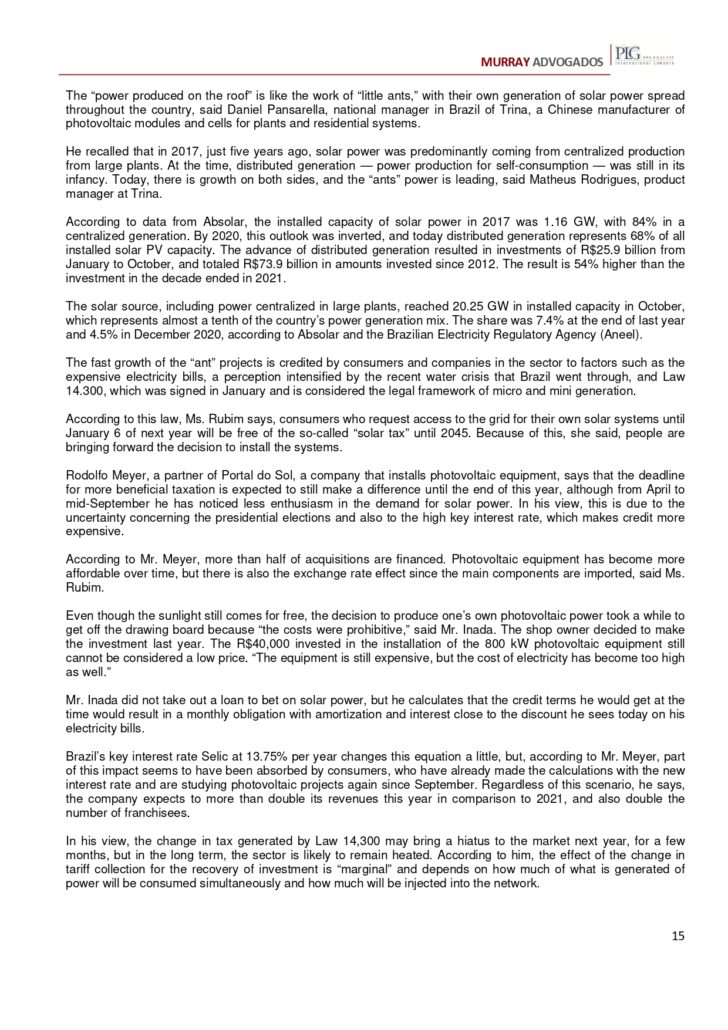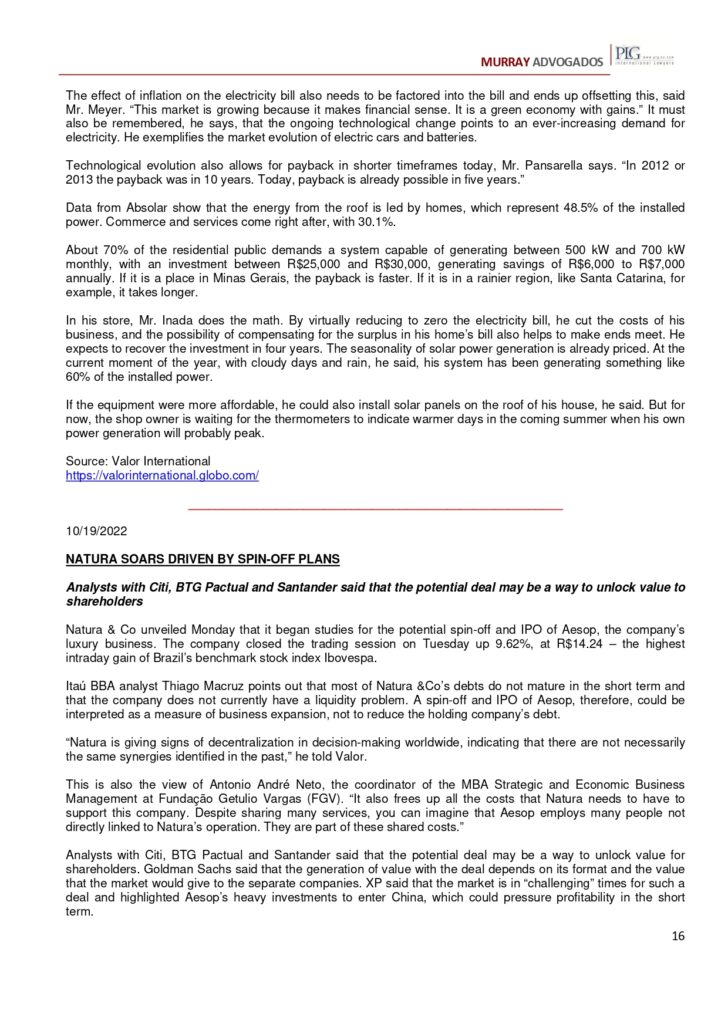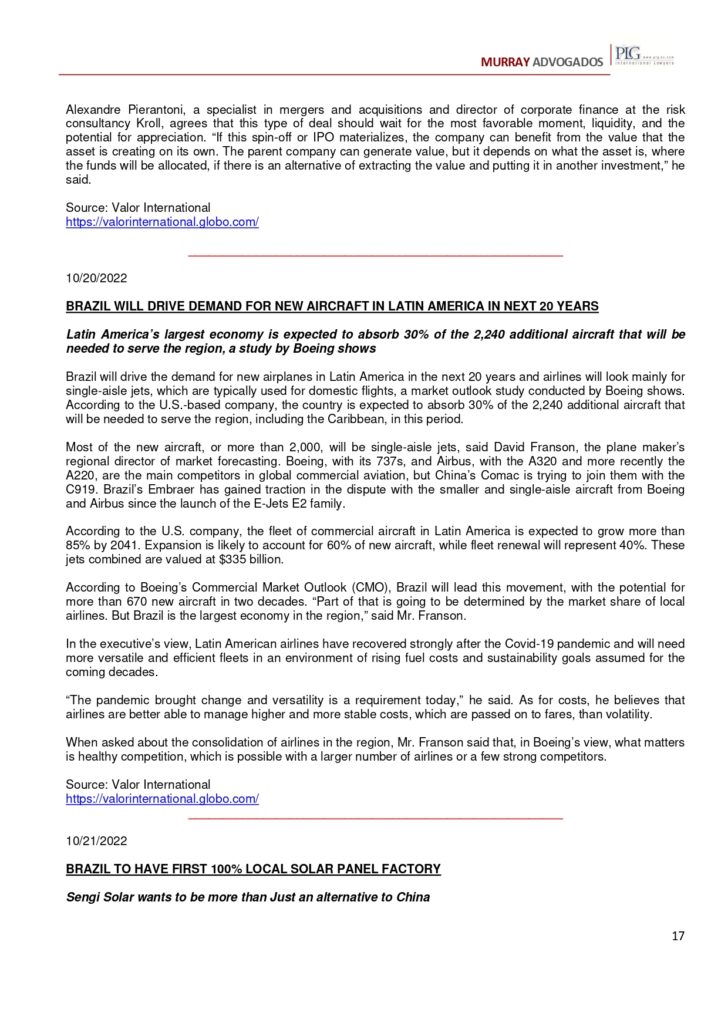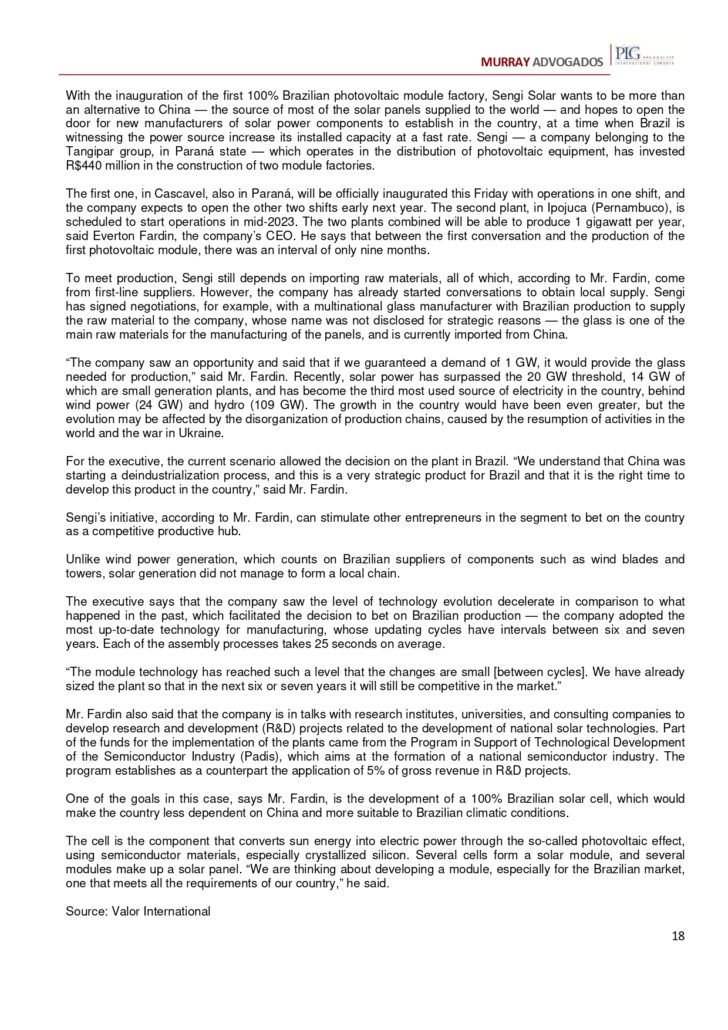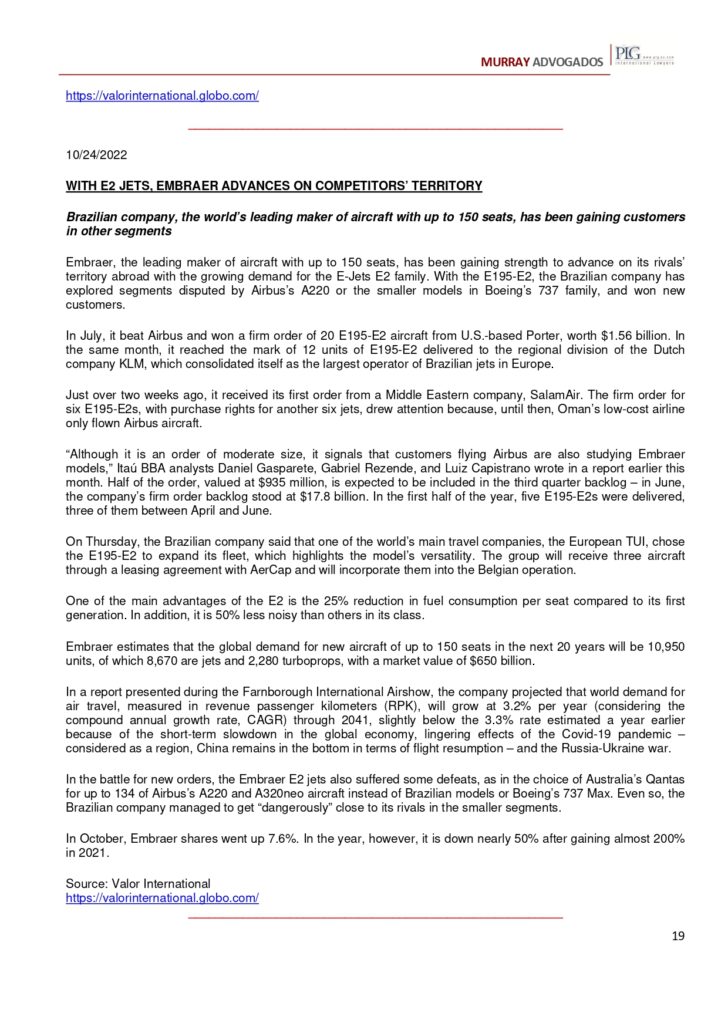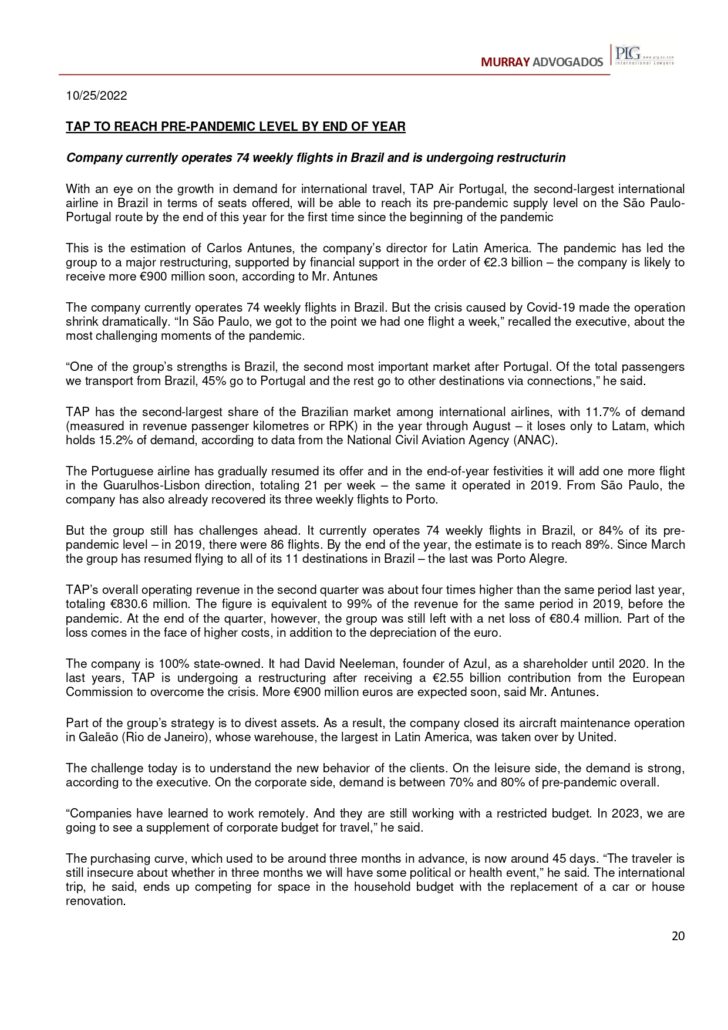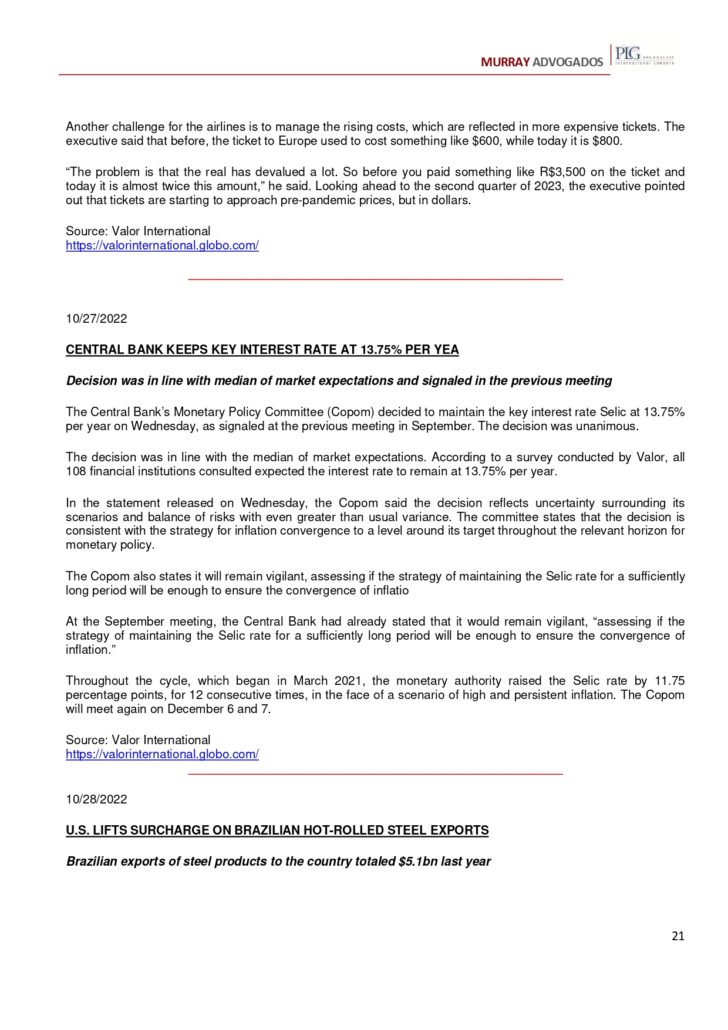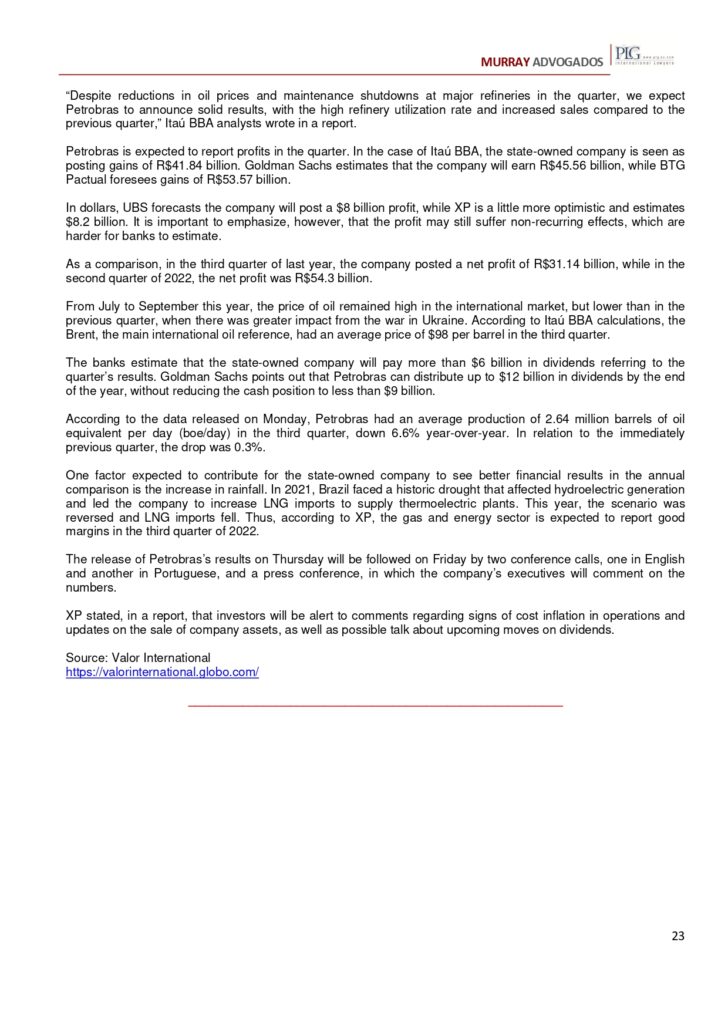Average revenue estimate of R$163.7bn represents 34.6% increase over 2021
10/31/2022
/i.s3.glbimg.com/v1/AUTH_37554604729d4b2f9f3eb9ad8a691345/internal_photos/bs/2021/x/2/bAvIGySuCnyfbSDQhnkg/pre.jpg)
Analysts expect that state-owned company will maintain good cash generation in the quarter — Foto: Geraldo Falcão/Agência Petrobras
Oil prices and the exchange rate are expected to have a prominent role in the third-quarter earnings report Petrobras is set to release after the market closes on Thursday. Analysts also cite the greater use of refineries and falling imports of liquefied natural gas as important factors. The average of forecasts of three banks compiled by Valor suggests a net income of R$163.7 billion, which would mean a 34.6% year-over-year growth.
The analysts’ expectation is that the state-owned company will maintain good cash generation in the quarter and announce new dividend payments on Thursday. The projections of BTG Pactual, Goldman Sachs, and Itaú BBA for revenue vary between R$153.3 billion and R$177.89 billion.
On average, the three banks estimate an EBITDA of R$95.2 billion, which would represent a 15% increase over the third quarter of 2021.
“Despite reductions in oil prices and maintenance shutdowns at major refineries in the quarter, we expect Petrobras to announce solid results, with the high refinery utilization rate and increased sales compared to the previous quarter,” Itaú BBA analysts wrote in a report.
Petrobras is expected to report profits in the quarter. In the case of Itaú BBA, the state-owned company is seen as posting gains of R$41.84 billion. Goldman Sachs estimates that the company will earn R$45.56 billion, while BTG Pactual foresees gains of R$53.57 billion.
In dollars, UBS forecasts the company will post a $8 billion profit, while XP is a little more optimistic and estimates $8.2 billion. It is important to emphasize, however, that the profit may still suffer non-recurring effects, which are harder for banks to estimate.
As a comparison, in the third quarter of last year, the company posted a net profit of R$31.14 billion, while in the second quarter of 2022, the net profit was R$54.3 billion.
From July to September this year, the price of oil remained high in the international market, but lower than in the previous quarter, when there was greater impact from the war in Ukraine. According to Itaú BBA calculations, the Brent, the main international oil reference, had an average price of $98 per barrel in the third quarter.
The banks estimate that the state-owned company will pay more than $6 billion in dividends referring to the quarter’s results. Goldman Sachs points out that Petrobras can distribute up to $12 billion in dividends by the end of the year, without reducing the cash position to less than $9 billion.
According to the data released on Monday, Petrobras had an average production of 2.64 million barrels of oil equivalent per day (boe/day) in the third quarter, down 6.6% year-over-year. In relation to the immediately previous quarter, the drop was 0.3%.
One factor expected to contribute for the state-owned company to see better financial results in the annual comparison is the increase in rainfall. In 2021, Brazil faced a historic drought that affected hydroelectric generation and led the company to increase LNG imports to supply thermoelectric plants. This year, the scenario was reversed and LNG imports fell. Thus, according to XP, the gas and energy sector is expected to report good margins in the third quarter of 2022.
The release of Petrobras’s results on Thursday will be followed on Friday by two conference calls, one in English and another in Portuguese, and a press conference, in which the company’s executives will comment on the numbers.
XP stated, in a report, that investors will be alert to comments regarding signs of cost inflation in operations and updates on the sale of company assets, as well as possible talk about upcoming moves on dividends.
*By Gabriela Ruddy — Rio de Janeiro
Source: Valor International
Dynamism can help Brazil navigate almost unscathed through the stormy crisis raging abroad, economist says
10/31/2022
/i.s3.glbimg.com/v1/AUTH_37554604729d4b2f9f3eb9ad8a691345/internal_photos/bs/2022/W/l/ZdBwANQFeAYCRaW1gmkA/080922ubs35.jpg)
Alexandre de Ázara — Foto: Silvia Zamboni/Valor
The dynamism of Brazil’s spending has helped create a stronger economy in Brazil. With an investment rate comparable to the best periods of the Workers’ Party (PT) administrations, the country has a potential growth – without generating inflation – of 2.5% in the coming years, said Alexandre de Ázara, the chief economist of UBS BB.
The confidence in this accelerating effect of investment on the Brazilian economy shapes the bank’s optimistic view about the country’s macroeconomic scenario. UBS BB was among the first to bet on stronger growth and lower inflation in 2022. The scenario for 2023 is the same. Mr. Ázara foresees 1.4% growth next year and put Brazil’s official inflation index IPCA at 4%. The medians of the Central Bank’s Focus survey with economists are, respectively, 0.6% and 4.9%.
Such dynamism can help Brazil navigate almost unscathed through the stormy crisis raging abroad, the economist said. In a world very concerned about inflation in the United States and the slowdown in China, “Brazil became the darling, but in a relative ‘ugly contest’.”
However, it is key to know from the winner of the presidential election what the fiscal policy will look like. “If a proposal comes out to take items out of the spending cap and a R$200 billion waiver, I think the reaction will be very negative.”
Read below the main excerpts from the interview:
Valor: What supports UBS’s more optimistic view on Brazil’s economy?
Alexandre de Ázara: At the worst moment in 2020, we projected that GDP would contract 6% to 7%, and the most pessimistic analysts were talking about 10%. In 2021, we expected growth close to 2%, it ended up at 4.6%. For this year, we started with something between zero and 0.5%, and it will end up close to 3%. In other words, for three years now, we, the economists, have been consistently underestimating Brazil’s GDP growth. I wanted to make this introduction to answer the question. I looked at the longer-term perspective, breaking down factors of production by capital, labor and productivity. We know that productivity growth was very high during the Lula administration. Between 2003 and 2013, it was 1% and 2% all the time, but it collapsed during the Rousseff administration and never recovered. My longer-term reading is that this increase in productivity, which made us imagine potential GDP at 4% or even 5%, was the effect of the creation of the credit market in Brazil. Until 2003, companies were not able to get a loan running for more than a year. Only the big ones could. Apart from that, we had the demographic dividend [when an economy grows as a result of a change in the age structure of its population], which peaked at that time. In 2014 and 2015, the economic policy led Brazil into a crippling recession, of 7%. There was then an uncoordinated but common economic policy response of classifying the country’s capital stock as excessive. And the only way to destroy excessive capital, without war or natural disaster, is to have depreciation. Then in 2014 the investment rate fell to close to 10% of GDP, which did not change despite the lower interest rates. One theory to explain that is that the interest rate had lost the power to drive investment. The other theory, which I like better, is that the power is the same, but there was a much higher capital stock than desired. It is difficult to demonstrate this in practice, but I can use this as a backdrop for my scenario. The economic recovery from the second half of 2016 onward brought a 1.7% GDP growth. Why wasn’t it higher? Because the capital stock was still excessive. But at some point between 2018 and 2019 that process must have ended. Then the pandemic hit and we could not realize that.
Valor: Does investment made GDP growth surprise to the upside?
Mr. Ázara: After breaking down GDP growth by consumption, investment, and government spending, the only component of GDP that is above pre-pandemic levels is investment, and by a lot. Investment is now close to 18% of GDP. This is the highest investment rate in Brazil since 2010, when the Economist magazine made that cover with Christ the Redeemer taking off. This increase in the ratio of investment to GDP, and also a higher-quality investment, has a very important accelerating effect, and that is why GDP has been surprising to the upside for two years now. This was not clear to anyone. Economists look at these numbers often because they don’t change all the time, but they tell a compelling story. That is why we have 1.4% GDP [projection] for next year. Another thing is that in order to calculate GDP in the short term, one thing many do is use data from China as a kind of proxy for world trade. Before the lockdowns [because of the zero-Covid policy], that proxy served well. That has changed. A lockdown in Macau, China, causes a contraction of demand and supply of services in that country that doesn’t necessarily impact the world in the same way.
Valor: But shouldn’t this investment rate fall with the rise in the Selic rate?
Mr. Ázara: There was a prevailing view that if interest rates went up, the investment would slow down, but this didn’t happen. Investment grew in this period only because a high rate of return was expected, and this only occurs because productivity will be good. And there is no public spending, this is the beauty of it, the greatest proof that we don’t need public spending to grow. [Former President] Dilma Roussef’s economic policy [2011-2016] focused on public spending, and I understand that she had the best of intentions, but it doesn’t work. The GDP fell by 7% and unemployment increased, creating uncertainty for families.
Valor: You are also more optimistic about inflation.
Mr. Ázara: I am more optimistic about inflation next year. There is a relative price of goods to be adjusted because of the normalization of world supply. It is not a permanent move, but it is likely to help to smooth out dynamics in the next 12 months. That is why I have a more optimistic projection than the market for this. My projection for services inflation, on the other hand, is closer to the consensus.
Valor: What is the potential GDP projection UBS works with for Brazil?
Mr. Ázara: We think the country can grow close to 2.5% in the next two or three years. For the long term, however, this number is closer to 2%. In order to improve, we have to make structural reforms that I don’t think either of the two candidates in the runoff vote will be able to do.
Valor: And what are these reforms?
Mr. Ázara: To grow above 2% a year, there is a list. But I think two are more important. The first is a new pension reform. Brazil still has very privileged civil servants. The rules that apply to them do not apply to the private sector. The second is to make a tax overhaul together with a spending overhaul, and a fiscal overhaul. This is my vision. If this is done, I think Brazil can grow by 3%, maybe even 4% a year.
Valor: You don’t believe in relevant reforms in either scenario?
Mr. Ázara: The taxation of dividends is the only measure likely to pass. Discussion in Congress is ripe, it is likely to be voted on. I think it is the only one. There is, in fact, an asymmetry, where business entities don’t pay taxes. Journalists, the financial market, lawyers, and engineers are the ones who most fit into these special tax situations. I worked for years in asset management and did not pay income tax because I received everything as dividends. I think it is a fair discussion.
Valor: Tax collection has been surprising along with economic activity, and has given the government room to maneuver. Can this situation persist in 2023?
Mr. Ázara: I believe so. We need, obviously, that the initial fiscal conditions are not bad. The winner of the runoff vote will have to ask for a fiscal waiver for next year’s target. If it is something north of R$100 billion, I think we will start off on the wrong foot. I like the idea of starting with R$50 billion, leaving more R$50 billion contingent on the approval of a new fiscal rule. But if this new rule keeps things out of the spending cap as if there was no limit, the market will misread it. It has to be a consistent rule that embraces everything: it can have some flexibility, and it can allow some additional spending contingent to the level of debt/GDP – if debt drops, for example, the government can spend more. This discussion is likely to last for the first six months of the administration.
Valor: To what extent can this more pessimistic scenario for the economy abroad affect Brazil?
Mr. Ázara: I was this month at the meeting of the International Monetary Fund (IMF) and the consensus is that Brazil has become the darling but in a relative “ugly contest.” The world is very concerned about a recession caused, mainly, by an excessive monetary tightening in the United States and a slowdown in China. The main reason Brazil suffers less is that Brazil always suffers less because it is a large and closed economy. We only export 10% of what we produce, we only import 10%. Besides this, the percentage of debt in the hands of foreigners is at a historic low, and the Central Bank, starting the year with fiscal and elections challenges, normalized the monetary policy earlier. Another question is whether the risk premium on the fiscal policy dominates the external risk.
Valor: Doesn’t growth fueled by the services sector, while industry and retail are falling, signal a worse quality GDP?
Mr. Ázara: I believe not. We spent a long time with a greater demand for goods. It was reasonable to have this adjustment. I don’t think it means a forecast of worse growth ahead. Investment is a very positive story. It is what rules the rest. Everybody is a little concerned and thinks that the situation is bad, but is investing. The general perception is worse than the sectorial situation, specific to each company. I believe that investment can be maintained for a while longer, contingent upon responsible fiscal choices. If it is irresponsible, it will fall to 10%, the same as it was during the Dilma Rousseff period. It has nothing to do with the ruler, but his choices will determine this.
*By Marcelo Osakabe — São Paulo
Source: valor International
Situation of external account expected to remain benign, but in less relaxed picture than previously estimated
10/31/2022
/i.s3.glbimg.com/v1/AUTH_37554604729d4b2f9f3eb9ad8a691345/internal_photos/bs/2021/G/w/jJgaw5Sner2piEpAsBlQ/ping-011019david13.jpg)
David Beker — Foto: Silvia Zamboni/Valor
Brazil’s foreign trade is at record levels, with flows increasing considerably. Although analysts view the country’s trade opening positively, it also results in greater exposure of the economy to global fluctuations amid the prospect of an increasingly unfavorable external scenario.
The worsening terms of trade (a measure of a country’s export prices relative to its import prices) and the cooling demand in major markets negatively impact the country’s trade balance and its current account, which shows the transactions of goods, services, and income of Brazil with foreign countries. The situation of the external account is expected to remain benign, but with less room than previously estimated.
Using Central Bank data, Bank of America (BofA) shows that Brazil’s two-way trade, measured by the weight of exports and imports over the country’s GDP, renewed a record in September this year, reaching 37.41%, up from 31.84% in the same period last year and 22.92% in September 2019, before the pandemic.
Brazil has historically been an exporter of commodities, with increasing trade opening since its re-democratization in the late 1980s, notes BofA. At the same time, as the country has grown, imports have also increased.
“The scope of the Brazilian economy opening, however, seems to have accelerated considerably in the last four to five years, as the country’s international trade, in terms of GDP, has increased from less than 20% to almost 35% of GDP in that period,” said David Beker, David Hauner and Claudio Irigoyen, with BofA. “Such a development, while generally positive, results in a greater exposure of the Brazilian economy to global fluctuations.”
Monthly data show that the most recent gain in the representation of trade flows over activity is explained by both rising import and export levels. On the export side, however, most of the growth comes from higher prices, while imports are driven by both higher quantities and values.
Commodity prices soared at the beginning of the year – with a slowdown in recent months, pondered BofA – influenced by the conflict between Russia and Ukraine, which benefited exports.
Manufactured items, which are the bulk of Brazil’s imports, also saw large price increases because of persistent problems in global chains after the Covid-19 shock.
Price changes, however, were asymmetric, BofA points out, with import values growing significantly more (30.1%) than export values (16.3%) when comparing the period of January to August with the same period in 2021. “As a result, the terms of trade fell by 10.5% over this period, hurting the balance of trade results,” the bank’s team said.
In addition, Brazil’s relative economic performance has also been stronger, they say. Increased domestic consumption drives up imports, exacerbating the already adverse price movement. “In the third quarter, the quantity imported was the main highlight and showed important growth, even when we take into account the positive surprises with the GDP,” said Bradesco’s economists Rafael Murrer and Myriã Bast, in a report.
The deterioration of the global scenario, as major economies continue to show signs of slowing and central banks around the world adopt a more aggressive stance in their interest rate hike cycles, also plays a role, BofA said. “This has reduced demand for Brazil’s exports from key markets such as China,” the bank’s team says.
All these combined effects are driving more imports than exports and have led to lower-than-expected trade balance figures, consequently leading to revisions in the projections for the current account of the balance of payments.
BofA increased its projection for this year’s current account deficit to $32.5 billion (1.7% of GDP) from $10 billion (0.5% of GDP). The new figure reflects a lower-than-expected trade balance, which went to $55 billion from $65 billion. Bradesco, which expects a $40 billion deficit (2.1% of GDP) in the current account in 2022, projects a trade balance of $58 billion this year, which would be equivalent to $47 billion in the balance of payments.
The Economy Ministry’s foreign trade statistics use a different methodology than the Central Bank’s to calculate trade transactions, since the ministry only accounts for the physical movement of goods, while the Central Bank considers any transaction where ownership is transferred between residents and non-residents.
In its latest Quarterly Inflation Report (RTI), published in September, the Central Bank lowered its projection for the trade balance in 2022 to $42 billion from $86 billion, after raising the forecast for imports and reducing that for exports. With this, its estimate for the current account went from a slight surplus of $4 billion (0.2% of GDP) to a deficit of $47 billion (2.5% of GDP). In the Focus, Central Bank’s weekly survey with economists, the median of forecasts indicates a smaller deficit, of $32.3 billion.
Also weighing on the recent changes in the current account projections are new estimates for the balance of services and primary income. The Brazilian balance of services – which accounts for expenses with international travel and equipment rental, for example – is traditionally in deficit. In the pandemic, as global mobility was halted, it reached the lowest negative figures since the 2008 crisis, of $17.1 billion in 2021. Now it is expected to return to something closer to pre-pandemic – in 2019, the deficit was $35.5 billion. Bradesco projects a $32.1 billion deficit. BofA has increased its deficit forecast to $30 billion from $25 billion.
“For primary income, the main highlight is high profit and dividend remittances, which have been higher than previously expected,” said Mr. Murrer and Ms. Bast, with Bradesco, forecasting a $58.4 billion deficit. BofA adjusted its projection to a negative balance of $57.5 billion from a negative balance of $50 billion. The growth in remittances may reflect, according to economists, both stronger activity in Brazil and greater uncertainty about the country’s future.
Even with the downward revisions to the current account balance, Brazil’s external accounts remain at a comfortable level, because the deficit is largely financed by inward direct investment (IDP), whose projections have even been revised upwards.
The strong flows took Bradesco’s IDP estimate to $75.1 billion this year (4% of GDP), influenced mainly by the improvement in domestic activity and the high level of interest rates. BofA raised its projection to $70 billion from $60 billion in 2022.
“Brazil maintains a comfortable condition in relation to its external account, even if the picture is less ‘loose’ than originally estimated. According to our projections, we will continue to be better positioned than some emerging peers,” said Bradesco’s economists.
Livio Ribeiro, a partner at BRCG consulting and associate researcher at the Fundação Getulio Vargas’s Brazilian Institute of Economics (Ibre-FGV), ponders that the aggregate financing level, however, is low.
“The sources of funds in the balance of payments go far beyond direct investment. There are fixed income flows, portfolio flows, and loan rollovers. And what we have seen is an outflow of fixed income, a big decrease in portfolio flow, and roll-over rates of less than 100% – that is, the pace of taking new loans is lower than the amortization of the old ones,” Mr. Ribeiro explains.
This general structure of less abundant financing, according to him, reflects a world that is more challenging and occurs simultaneously with the process of faster acceleration of the current account deficit than was assumed. “By no means do we have an external constraint problem, but the slack that was thought to exist in the current account is smaller, and the aggregate financing slack is smaller still,” he said, projecting a current account deficit of $45 billion (2.5% of GDP) in 2022.
*By Anaïs Fernandes — São Paulo
Source: Valor International
Brazilian exports of steel products to the country totaled $5.1bn last year
10/28/2022

The United States decided not to extend countervailing antidumping measures against Brazilian exports of hot-rolled steel products, which were in force since October 2016, according to a note released by Brazil’s ministries of Economy and Foreign Affairs on Thursday. The note mentions the United States International Trade Commission (USITC).
“The decision, announced last October 21, stems from the conclusion that the termination of the measures for Brazilian exports would not lead to the continuation or recurrence of material injury to the U.S. industry, which was demonstrated throughout the review process by exporters and through the joint action of the Ministry of Economy and the Ministry of Foreign Affairs,” it says.
Thus, no more additional taxes of up to 45.58% (34.28% antidumping duty and 11.3% countervailing measure) will be charged on imports of hot-rolled products from Brazil.
Still according to the two ministries, there were no changes in relation to other countries subject to the same measures (Australia, Japan, South Korea, Netherlands, Russia, Turkey, and the United Kingdom, in the case of antidumping duty, and South Korea, in the case of countervailing measure), which means that Brazil was the only country excluded.
In July, the Commission had taken a similar decision, regarding Brazilian exports of cold-rolled steel products. There were additional duties of up to 46% (35% antidumping duty and 11% countervailing measure), which were no longer charged. Likewise, Brazil was the only country excluded from the list of exporters whose sales were surcharged.
Brazilian exports of steel products totaled $9.3 billion last year. Of this, $5.1 billion were destined for the United States.
Also according to the note, hot-rolled steel products represented, before antidumping and countervailing measures, exports of nearly $150 million to the U.S. market.
*By Lu Aiko Otta — Brasília
Source: Valor Inernational
Group is targeting concessions in three states, São Paulo, Minas Gerais, and Rio Grande do Sul
10/28/2022
/i.s3.glbimg.com/v1/AUTH_37554604729d4b2f9f3eb9ad8a691345/internal_photos/bs/2022/C/I/9QkEoKTUe8DHOXKiQImg/251022carlos36.jpg)
Carlos Eduardo Castro — Foto: Silvia Zamboni/Valor
The Águas do Brasil group is getting ready to dispute new sanitation contracts. At least three projects are on the radar: the municipal concessions of Marília (São Paulo) and Nova Serrana (Minas Gerais), in addition to the privatization of Corsan (Companhia Riograndense de Saneamento), according to Carlos Eduardo Castro, who will take over as the company’s head of new business and regulation on November 1.
The executive headed Águas do Brasil until 2019, when he left the group to take command of Copasa (Companhia de Saneamento de Minas Gerais). Now, Mr. Castro ends a four-month quarantine after leaving his position at the state-owned company and returning to the private group. “My return matches a new moment for the group. Today it is a company of a different size, which went through a corporate reorganization and has the appetite to grow in a structured way,” he says.
In August, the company officially took over the new contract in Rio de Janeiro, which was won in an auction at the end of 2021. In this operation, in which Águas do Brasil is a partner of the management company Vinci Partners, investments of R$4.7 billion are foreseen for the universalization of services in the west zone of the state capital and 18 other cities in the state of Rio de Janeiro.
Even with the new operation, the group is already prepared to bid for auctions, according to Mr. Castro. Today, at least three projects are on the radar: the municipal concessions of Marília (São Paulo) and Nova Serrana (Minas Gerais), as well as the privatization of Corsan (Companhia Riograndense de Saneamento).
Even with the new obligations assumed, the group can absorb new business, according to Mr. Castro. “In Rio de Janeiro we have set up a capital structure in which the concessionaire will have its own capacity to generate resources and financing, without creating additional commitments for the holding company,” he says.
The group’s forecast is to reach the end of 2022 with revenues of R$1.6 billion, Ebitda of R$560 million, and financial leverage of 2.1 times net debt by Ebitda.
“The group has leverage under control and very positive ratings from credit agencies. In addition, there is an expectation of revenue expansion starting in 2023. The contract in Rio will increase revenue by 50%, and we have a portfolio of mature concessions that allow us to generate cash for new business,” says the executive.
Mr. Castro also highlights that, depending on the profile of the business, Águas do Brasil will seek strategic partners to make investments feasible.
This would be the model in case the company disputes the Corsan privatization auction, says Mr. Castro. “If the bidding takes place this year, we are studying and discussing with potential partners, depending on the size of the operation,” he says.
The Rio Grande do Sul government plans to carry out the privatization in December this year. Sector analysts evaluate that the deadline is tight and point out that the process will depend on the result of the runoff of the elections in the state, in which former governor Eduardo Leite (Brazilian Social Democracy Party, PSDB) is running for reelection against Onyx Lorenzoni (Liberal Party, PL), who has already made statements against the project.
Today, Águas do Brasil’s operations are concentrated in the Southeast region. The group operates concessions in 32 cities in Rio de Janeiro, São Paulo, and Minas Gerais. The presence in these states increases the group’s interest in new municipal projects in the region — such as the Nova Serrana and Marília contracts, which may still be tendered this year. However, the company is also interested in expanding its operations to other regions of the country, says Mr. Castro.
When it comes to choosing the auctions, it will compete for, one of the main criteria for the company is commercial management control. For the group, the interest increases when the contracts offer the possibility of management with the customers because it is an area in which the company can extract many efficiency gains, says the executive.
Not all concessions give the private company this control. For example, in the case of the sanitary sewage PPPs in Ceará, whose auctions were held this year, only part of the operation was handed over, and the commercial management remained in the hands of the state-run company. Águas do Brasil did not participate in this auction. “It doesn’t mean that we won’t enter projects with this profile, but it has less attractiveness,” he says.
The expectation is that the pace of privatizations in basic sanitation will remain high starting in 2023, according to Mr. Castro. “Whatever the winner [of the presidential elections], sanitation will remain on the agenda. It is unthinkable to imagine any setback or measure that does not attract capital. We believe that the issue will be treated less ideologically and more pragmatically”, he affirms.
In his evaluation, what may change depending on the winners will be the profile of the privatizations that will be proposed.
He gives as an example the states of Rio Grande do Sul and São Paulo, where the candidates running in the runoff of the elections have different points of view about the privatization of the state’s water and sewage companies. For Mr. Castro, even those who do not defend the sale of the companies should study other forms of privatization, such as concessions or PPPs. “Regardless of the ideology of the governor, there is an understanding that some movement will have to be made. For the market, this is what matters,” he says.
“In Rio Grande do Sul, we have two very clear situations, with Mr. Leite and Mr. Lorenzoni, who said he would not privatize Corsan. This decision will not prevent the government from looking for another format. Some other model will have to be taken. In São Paulo, [Fernando] Haddad (Workers’ Party, PT) may also seek other paths”, he says.
Concerning Minas Gerais, the executive highlights that it is necessary to overcome some legislative steps to privatize Copasa — it would be necessary to change the State Constitution, which today requires a referendum in case of privatization. “The reelection and the construction of a base will be able to push this and other projects forward. We will have some movement to expand private participation in Minas Gerais, whether it will be a sale or another arrangement, time will tell.”
*By Taís Hirata — São Paulo
Source: Valor International
Between July and September, economy generated 1 million jobs, well below the 3 million in the previous quarter
10/28/2022
Brazil’s labor market ended the third quarter at a still strong pace: the unemployment rate is down and the average income of workers has increased for the first time since the beginning of 2021. Despite the seemingly positive figures, analysts are adopting a cautious tone as they foresee a slowdown in the coming months.
According to data from the Continuous National Household Sample Survey (Pnad Contínua), Brazil’s unemployment rate stood at 8.7% in the September quarter, down 0.2 percentage point compared with the August quarter.
The result was in line with the median of projections collected by Valor, which ranged between 8.6% and 8.8%. In the same period of 2021, the unemployment rate was 12.6%.
This means that the country had 9.5 million unemployed people – people aged 14 or older who looked for a job in the period but could not find one. This is the lowest since the fourth quarter of 2015. The employed population, meanwhile, reached 99.3 million people, a record since records began, in 2012.
The recovery in employment seen since last year has been driven by commerce, services, and public administration, said Adriana Beringuy, the coordinator of labor and income at the Brazilian Institute of Geography and Statistics (IBGE). The latter contributed to one third of the jobs generated in the last quarter – 291,000, up 8.9% year-over-year.
The growth was stronger among those who hold informal jobs in the public sector. In this group, the number reached 3.055 million people, also a record.
“This growth in the public sector may be linked to the move to recover the structure necessary to provide these public goods, health, and education. Besides that, there was growth within the public administration itself,” said Ms. Beringuy, who rejected the possibility of such growth having been influenced by the election.
“I think it’s mainly two forces combined. On the one hand, positions in the public sector are being filled again. On the other hand, many temporary jobs have been created in the last few months, especially for people IBGE hired for the census,” said César Garritano, an economist at Renascença.
Despite the improvement, the country still had 23.4 million underutilized workers in the third quarter. The contingent of informal workers reached 39.145 million in the third quarter. Nevertheless, given that the number of formal jobs was higher, the economy’s informality rate fell to 39.4% in the period.
For the first time since the first quarter of 2021, the average income has increased year-over-year – 2.5%, according to IBGE. Yet, this is largely explained by the cooling of inflation in the period, said Ms. Beringuy.
“We were already seeing gains in nominal income, but not in real terms. And this is now happening,” she said.
/i.s3.glbimg.com/v1/AUTH_37554604729d4b2f9f3eb9ad8a691345/internal_photos/bs/2022/n/s/9AIxskRke52EZMNBxN7g/161221xp071.jpg)
Rodolfo Margato — Foto: Claudio Belli/Valor
The heated labor market may continue to support the improvement in workers’ income, said Rodolfo Margato, an economist at XP Investimentos. “We believe that real income will continue on a recovery path in the coming months,” he wrote in a comment to clients, recalling that the indicator remains about 4% below the levels seen at the end of 2019.
Despite the good numbers, there is a slowdown in the cards, said Bruno Imaizumi, an economist at LCA Consultores. He notes that between July and September, the economy generated nearly 1 million jobs, well below the nearly 3 million seen in the previous quarter.
“This deceleration is also starting to become clear when you look at the Caged [General Register of Employed and Unemployed Workers] figures. Formal work will not be able to absorb all the people who joined the informal sector in the pandemic,” he said, pointing out that this was a trend that already appeared before the crisis, but was intensified by it.
That said, Mr. Imaizumi notes that the labor market tends to continue presenting positive results in the coming months. Still, the accommodation, food, and domestic services sectors have a deficit of 500,000 jobs compared to the pre-Covid scenario, he said.
*By Valor — Brasília
Source: Valor International
Survey by Strategy&Brasil with 750 publicly traded companies around the world show average revenue growth of 3.3% between 2017 and 2021
10/27/2022

A study conducted by Strategy& Brasil, PwC’s strategic consulting arm, with 750 publicly traded utilities companies around the world concluded that electric power and sanitation companies showed better financial performance in the last five years. The companies posted an average revenue growth of 3.3% between 2017 and 2021 driven by the electric power industry, with an average rate of 4.8%, and sanitation, with 4.3%.
The study is based on public data from companies that supply electricity, piped gas, water and sewage, and fuel services, as well as companies classified as “multi-utilities,” which operate in more than one field. The financial data are represented in dollars to gauge the real growth of the companies and allow comparison among them.
The study also shows that the 43 Brazilian companies that were part of the study had a significant improvement in return rates, but shrinking revenue in dollars because of the devaluation of the real between 2017 and 2021, which caused a loss of competitiveness compared to the rest of the industry worldwide.
In the case of Brazilian companies, what has been verified over the last five years was a very significant improvement in the return on invested capital. By the way, most Brazilian companies are classified in study as “cash cows” – an expression for companies with high cash generation.
The problem is that all this evolution ends up being overshadowed by the depreciation of the real from 2017 onwards, which means that although they have grown in local currency, the weakened real has caused Brazilian power companies to lose competitiveness against their global peers, said Daniel Martins, a partner at Strategy& Brasil.
According to Mr. Martins, part of the good performance of the electric power utilities pointed out in the study was due to companies that work with renewable power generation and groups that operate in segments such as distribution and transmission. This is because, according to the specialist, the market’s greater interest in companies linked to the energy transition reflects in better returns and higher growth rates of these companies compared to corporations focused on fossil energies.
As an example, Strategy& shows that the future value-to-EBITDA ratio of renewable energy companies has an average of 11.7 times, against 11.2 times of fossil companies. Renewable companies also had an average real revenue growth rate of 5% per year, against 2.3% for fossil companies.
Another point in question is the execution of the strategies by the companies, which resulted in gains in market capitalization of more than four times the average of the other companies. On the other hand, companies that were not successful in implementing their projects have lost an average of 11% in market capitalization over the last five years.
“This shows that execution is as important as strategy,” said Mr. Martins.
*By Fábio Couto — Rio de Janeiro
Source: Valor International
Decision was in line with median of market expectations and signaled in the previous meeting
10/27/2022
/i.s3.glbimg.com/v1/AUTH_37554604729d4b2f9f3eb9ad8a691345/internal_photos/bs/2022/K/O/J5MU4DRbAAX68TwAaXQQ/bancocentral.jpg)
Central Bank’s building in Brasília — Foto: Jorge William/Agência O Globo
The Central Bank’s Monetary Policy Committee (Copom) decided to maintain the key interest rate Selic at 13.75% per year on Wednesday, as signaled at the previous meeting in September. The decision was unanimous.
The decision was in line with the median of market expectations. According to a survey conducted by Valor, all 108 financial institutions consulted expected the interest rate to remain at 13.75% per year.
In the statement released on Wednesday, the Copom said the decision reflects uncertainty surrounding its scenarios and balance of risks with even greater than usual variance. The committee states that the decision is consistent with the strategy for inflation convergence to a level around its target throughout the relevant horizon for monetary policy.
The Copom also states it will remain vigilant, assessing if the strategy of maintaining the Selic rate for a sufficiently long period will be enough to ensure the convergence of inflation
At the September meeting, the Central Bank had already stated that it would remain vigilant, “assessing if the strategy of maintaining the Selic rate for a sufficiently long period will be enough to ensure the convergence of inflation.”
Throughout the cycle, which began in March 2021, the monetary authority raised the Selic rate by 11.75 percentage points, for 12 consecutive times, in the face of a scenario of high and persistent inflation. The Copom will meet again on December 6 and 7.
*By Larissa Garcia, Alex Ribeiro — Rio de Janeiro, São Paulo
Source: Valor International
This could be largest the French group’s divestment in Brazil
10/27/2022
/i.s3.glbimg.com/v1/AUTH_37554604729d4b2f9f3eb9ad8a691345/internal_photos/bs/2022/8/N/2HUf9ZRtS08SbRVEtqSg/20emp-100-cerveja-b6-img01.jpg)
Cash-and-carry chain Assaí has a market capitalization of R$23 billion — Foto: Leo Martins/Agência O Globo
Casino is likely to sell a stake in the Brazilian cash-and-carry chain Assaí for nearly $500 million. The decision to study such a move was communicated Wednesday to Assaí’s board of directors. Casino is Assaí’s controlling shareholder with a 41% stake valued at R$9.4 billion. Assaí has a market capitalization of R$23 billion.
BTG Pactual, Itaú BBA and J.P. Morgan have been hired to “analyze the terms of the potential transaction,” which would be implemented through a secondary offering to be concluded at the end of November, Assaí said in a note. Casino stresses that no final decision has been made on the potential transaction. But sources told Valor that the group is likely to take this path.
The plan emerges following an increased risk of debt deterioration for the French group on the international market. The move also paves the way to improve the level of governance of the Brazilian chain. According to a source, the company is likely to turn itself into a company without a defined controlling shareholder after Casino’s partial exit, similarly to retailer Renner.
Changes may be made in this sense in the coming months, the source added, involving the appointment of Belmiro Gomes, Assaí’s current CEO, to the board of directors. Mr. Gomes would keep the executive position.
If confirmed, the $500 million deal will be the largest single asset sale made by the French group in Brazil or by one of its subsidiaries, such as GPA (owner of the Pão de Açúcar brand). The amount surpasses that of the sale of Via (owner of Casas Bahia) by GPA, which reached R$2.3 billion in 2019.
The group has had an asset sale plan in place for years to reduce its debt, with a target to reduce the equivalent of €4.5 billion by the end of 2023. However, the assets under negotiation do not yet reach this level.
According to the initial plans of the French company, there was no expectation of a partial sale of their position in Assaí, as Valor reported in September. But a recent worsening of market conditions forced the company to design an alternative path, a source familiar with the matter says.
“Banks have collaterals they can execute if debts come due, so it is the more general situation that is putting pressure,” a source said.
The credit risk measured by Casino’s five-year credit default swaps (CDS) rose to 12,970 basis points, from just 3,977 basis points at the beginning of the month, according to data compiled by Bloomberg.
The initial idea was to maintain the position in Assaí amid the prospect of short-term gains with a seamless business that is well-valued by the market, while seeking renegotiations with other assets, including GPA, in view of an eventual recovery of the valuation of the group, people familiar with the matter say. But this did not happen with GPA at the expected speed after the crisis caused by the pandemic and results still recovering.
After considering divestments in Assaí and Monoprix – another possibility on the table, according to two sources – Assaí would mean more immediate gain.
Another path being analyzed is the splitting of the Colombian group Éxito from GPA, its current controlling shareholder, to pave the way for selling the asset in Colombia. The business has posted high sales growth, but has low liquidity in the market. “But this is also a slower process than a deal with Assaí now,” said one source.
The reduction in Assaí’s stake comes 10 years after Casino became GPA’s largest controlling shareholder. In June 2012, Casino took control of the company, with the subsequent definitive departure of Abilio Diniz from the group after public disagreements with Casino’s chair and CEO Jean-Charles Naouri. The move occurs after the group sold retailer Via in 2019 to Michael Klein and a pool of funds and announced the spin-off of Assaí from GPA in 2020.
Today, investors and analysts believe that the decision to spin off Assaí was right, but that the French group has not been able to expand its retail business in Brazil in such an accelerated way, partly because of crises in 2016 and 2020, but also because of management decisions that did not give expected results in the retail arm, which is now being restructured.
Casino plans to reach March 2023 with debt around €2.5 billion, compared with a gross debt of €7 billion and net debt of €4.5 billion now. Rallye, Casino’s holding company, was placed under protection from creditors in 2019, and since then the group has been restructuring the debts of its operations.
(Ana Luiza de Carvalho contributed to this story.)
*By Adriana Mattos — São Paulo
Source: Valor International

